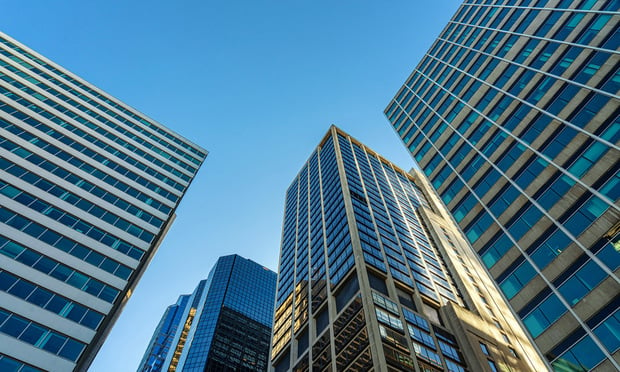
WASHINGTON, DC–Despite a bump in leasing volume in the fourth quarter, the District recorded a negative net absorption for 2016 of 51,800 square feet, according to CBRE's tally for the city. CBRE's Research Director Revathi Greenwood attributes this to a weakened rate of leasing velocity that was down by 31% compared to the ten-year average of 10.3 million square feet.
It should be noted here that DC's trophy office market was the exception. These buildings posted 829,000 square feet of positive net absorption in 2016, Greenwood tells GlobeSt.com.
By contrast, class B buildings had 823,000 square feet of negative net absorption as several large tenants moved into higher quality space including the Department of Homeland Security Office of the Inspector General, the Federal Election Commission and Amtrak. The East End continues to be hard hit. Although it accounted for the most leasing activity in 2016, it has been the largest contributor of negative net absorption.
A Bad Year for Leasing
Vacancy rates ended the year at 12.6%– an increase of 120 basis points year-over-year, the highest since 1992, according to CBRE.
The rise in vacancy rates can largely be attributed to over 750,000 square feet of new — and unfilled — space that came to market last year via seven building deliveries, Greenwood says.
However, it wasn't the new supply that held DC back last year — rather, Greenwood attributes the worst problems to factors beyond its control. “We started 2016 with a lot of stock market volatility and when that settled somewhat capital market spending remained constrained. Then we moved into the US presidential election season and activity was largely put on hold in the DC market as we waited for that to play out.”
2017 Poised to Be Better
2017, she says, should be more positive especially with both branches of Congress and the US presidency under one-party control. There will be increases in law firm and lobbying leasing as a result, she says.
Separately, Newmark Grubb Knight Frank's Benchmark report for Washington DC, released last year, also predicted positive absorption for office space going forward.
“We have had five years or more of negative absorption for office space,” Sandy Paul, NGKF's Managing Director of National Market Research told GlobeSt.com at the time. “We think we are coming to the end of that period and we will start to experience positive absorption.”
NGKF predicted that there will be about two million square feet of positive absorption a year going forward.
There is another round of building deliveries expected this year and next. But these nine buildings are already 60% pre-leased. This includes 700,000 square feet of space pre-leased to Fannie Mae at Midtown Center, more than 500,000 square feet leased to the Advisory Board at 655 New York Ave., NW and the 60,000 square feet law firm Fish & Richardson is taking at The Wharf. Additionally, Four Constitution Square at 150 M Street, NE, which broke ground in Q4, is fully pre-leased pre-leased to the Department of Justice.
But is there enough demand for the remaining 40% of new space, not to mention the existing vacancies? For the former, Greenwood says yes. “DC's market is highly differentiated and demand is concentrated on the premium sector.”
Trophy space will go quickly, she predicts, while Class B space will continue to struggle.

WASHINGTON, DC–Despite a bump in leasing volume in the fourth quarter, the District recorded a negative net absorption for 2016 of 51,800 square feet, according to CBRE's tally for the city. CBRE's Research Director Revathi Greenwood attributes this to a weakened rate of leasing velocity that was down by 31% compared to the ten-year average of 10.3 million square feet.
It should be noted here that DC's trophy office market was the exception. These buildings posted 829,000 square feet of positive net absorption in 2016, Greenwood tells GlobeSt.com.
By contrast, class B buildings had 823,000 square feet of negative net absorption as several large tenants moved into higher quality space including the Department of Homeland Security Office of the Inspector General, the Federal Election Commission and Amtrak. The East End continues to be hard hit. Although it accounted for the most leasing activity in 2016, it has been the largest contributor of negative net absorption.
A Bad Year for Leasing
Vacancy rates ended the year at 12.6%– an increase of 120 basis points year-over-year, the highest since 1992, according to CBRE.
The rise in vacancy rates can largely be attributed to over 750,000 square feet of new — and unfilled — space that came to market last year via seven building deliveries, Greenwood says.
However, it wasn't the new supply that held DC back last year — rather, Greenwood attributes the worst problems to factors beyond its control. “We started 2016 with a lot of stock market volatility and when that settled somewhat capital market spending remained constrained. Then we moved into the US presidential election season and activity was largely put on hold in the DC market as we waited for that to play out.”
2017 Poised to Be Better
2017, she says, should be more positive especially with both branches of Congress and the US presidency under one-party control. There will be increases in law firm and lobbying leasing as a result, she says.
Separately, Newmark Grubb Knight Frank's Benchmark report for Washington DC, released last year, also predicted positive absorption for office space going forward.
“We have had five years or more of negative absorption for office space,” Sandy Paul, NGKF's Managing Director of National Market Research told GlobeSt.com at the time. “We think we are coming to the end of that period and we will start to experience positive absorption.”
NGKF predicted that there will be about two million square feet of positive absorption a year going forward.
There is another round of building deliveries expected this year and next. But these nine buildings are already 60% pre-leased. This includes 700,000 square feet of space pre-leased to
But is there enough demand for the remaining 40% of new space, not to mention the existing vacancies? For the former, Greenwood says yes. “DC's market is highly differentiated and demand is concentrated on the premium sector.”
Trophy space will go quickly, she predicts, while Class B space will continue to struggle.
© Touchpoint Markets, All Rights Reserved. Request academic re-use from www.copyright.com. All other uses, submit a request to [email protected]. For more inforrmation visit Asset & Logo Licensing.







